The Muddy Archaeologist's Blog
Blog by Gillian Hovell, The Muddy Archaeologist www.muddyarchaeologist.co.uk
A Sense of Place: MEANDERING THROUGH MINOAN KNOSSOS
Whether you want to explore from the comfort of home, or planning to travel, here’s a chance to experience the ancient palace – over 3,000 years old – of Knossos on the Mediterranean island of Crete. Let me share with you how an archaeologist sees the site and features we discover along the way … Walk with me, as we peer into the corners and gaze at the open spaces of this Minoan palace, a place of myth and legend.
We arrive, to be greeted by the bust of the British archaeologist who dedicated years, and much of his fortune, to bringing the Minoans to the world’s attention.


Sir Arthur Evans excavated here in the 1900s and revealed the astonishing civilisation, so rich in material goods, in art, in culture and tradition which was based in the palaces dotted around the glorious island of Crete.
Who were the Minoans?
The only writing found of these people were in an undecipherable script – now called Linear A. So we have no idea what they called themselves. In c.750 BC, the epic poet Homer wrote of King Minos who ruled 90 cities in Crete, and so Evans called them the Minoans.
That Linear A script remains undeciphered. The famous Phaistos Disk was found in the palace further south and is well worth gazing at on a visit to the marvellous museum at Heraklion on Crete. You’ll see Linear A inscribed on ceremonial axes, clay tablets, etched onto huge pithia jars …



People arrived in Crete in Neolithic pre-Palatial times: little remains visible now on site from this era that lasted from 7,000 to 3,300 BC. It wasn’t primitive though: sea-faring, art and architecture are evident from the finds, now in Heraklion Museum.


What to Look for at Knossos
A Bronze Age period followed, and a Protopalatial period (2,000-1,750 BC) is similarly largely lost to sight under the later structures. However, Minoans’ Old Palace era (c.2,100-1,700 BC) flourished. It is from these early days that our first feature on the site of Knossos comes. The kouloura (named after the local round bread of Evans’ day) are round, stone-lined pits. Probably not water cisterns (due to lack of waterproofing ‘cement’ or lining), these were probably storage pits for grain. Even in these early days, it seems that the palace sites were central storage for the region …



Pause before entering the main site and look at the courtyard around you: a stone path is marked out, running alongside the walls: you’re looking at a processional way where, 3,000 years ago, great ceremonial processions advanced. The New Palace, reconstructed after some disaster c.1,700 BC lasted until c.1,450 BC when earthquakes and/or more were followed by the Mycenaeans quietly taking over.
For now though, we are in that New Palace era, over 3,500 years ago. Imagine the participants, the ritual items, the onlookers … the frescoes from Knossos (now in Heraklion Museum) give us a feel for the lively atmosphere.




And then we curve round, on the modern walkway towards the inner Palace. Peer down though, and notice how the central palace is raised up into the higher, fresh breezes, and how there are many structures below and outside the palace terrace. Compare these with images on the frescoes in Heraklion museum (and indeed, from the square-built Minoan style culture at Akrotiri on the island of Thera 100 miles north from here …)



Turning onto the ancient raised terrace, we walk by some of Evan’s colourful reconstructions that provide a sense of energy to this ancient site. But look around and see the ritual – the so-called Sacred Horns of Consecration – and the huge pithoi (the large clay jars used for storage), and their decoration of mock ropes around them. Art on an administrative jar – a sign of wealth and of prestige in the storage of its contents.
Look down too and see the water management – a sure indicator of organised, planned building and power. And beneath the reconstructed pillars (originally upside down tree trunks, narrow end at the base) you will find the original stone bases for the columns … Already, evidence is mounting for a powerful ancient Bronze Age centre …





Climb a few steps on the tourist path and look down into the great magazines, the storage centre of the palace. Deep, cool, and organised, the structure contained the provisions for the palace and beyond. Look closer and the blackening reveals a terrible fire that burned down this storage area …


Now you face the maze of Knossos. Turn left and head into the multi-storey reconstruction by Evans. Or head down, to the lower reconstruction and the great courtyard.
Let’s head up first …
Love them or loathe them, these ‘modern’ reconstruction structures of Evans help us to image the site as it might have once been and they certainly put Knossos on the map for tourism (and it remains the first call for cruise ships …). Other palaces are available … quieter, off the cruise ship route, and largely lacking reconstruction. But Knossos is a great place to learn what to look for in these Minoan palaces.
After a sudden destruction (earthquake?), the fantastic Minoan New Palace era (c.1,700-c.1,450 BC) thrived, with its art focussing on nature and ceremony. War rarely gets a look in (Homer wrote that Minos had a mighty navy; Knossos certainly feels like a secure site, confident in its own safety. As we walk though Evans’ brightly painted multi-storied reconstructions, we can view replica frescoes. We can gain a sense of the light-wells that kept fresh air flowing through the heat of a Cretan summer, and we can feel the majesty of the view as we look down on the central courtyard from the palatial quarters …




Pop down to the Courtyard and head back into the reconstruction of the ground floor ‘throne room’, with its ancient paving and benches still present. As with all reconstructions, not everything is as it once was. Of course, the colours are largely recreated and touched up and be aware that the basin so neatly placed in the centre of the room was actually found in a nearby corridor. Nonetheless, it is astonishing how much had actually survived 3,000 years.





Outside this grand audience room, at the heart of the site, we can stand in the great courtyard, edged by royal quarters and an essential sanctuary for sacred objects. Cult and ceremony have physical evidence in Minoan sites. We can glimpse them by imaging the noise and pomp and ceremony hinted at in the frescoes and figurines in Heraklion Museum.


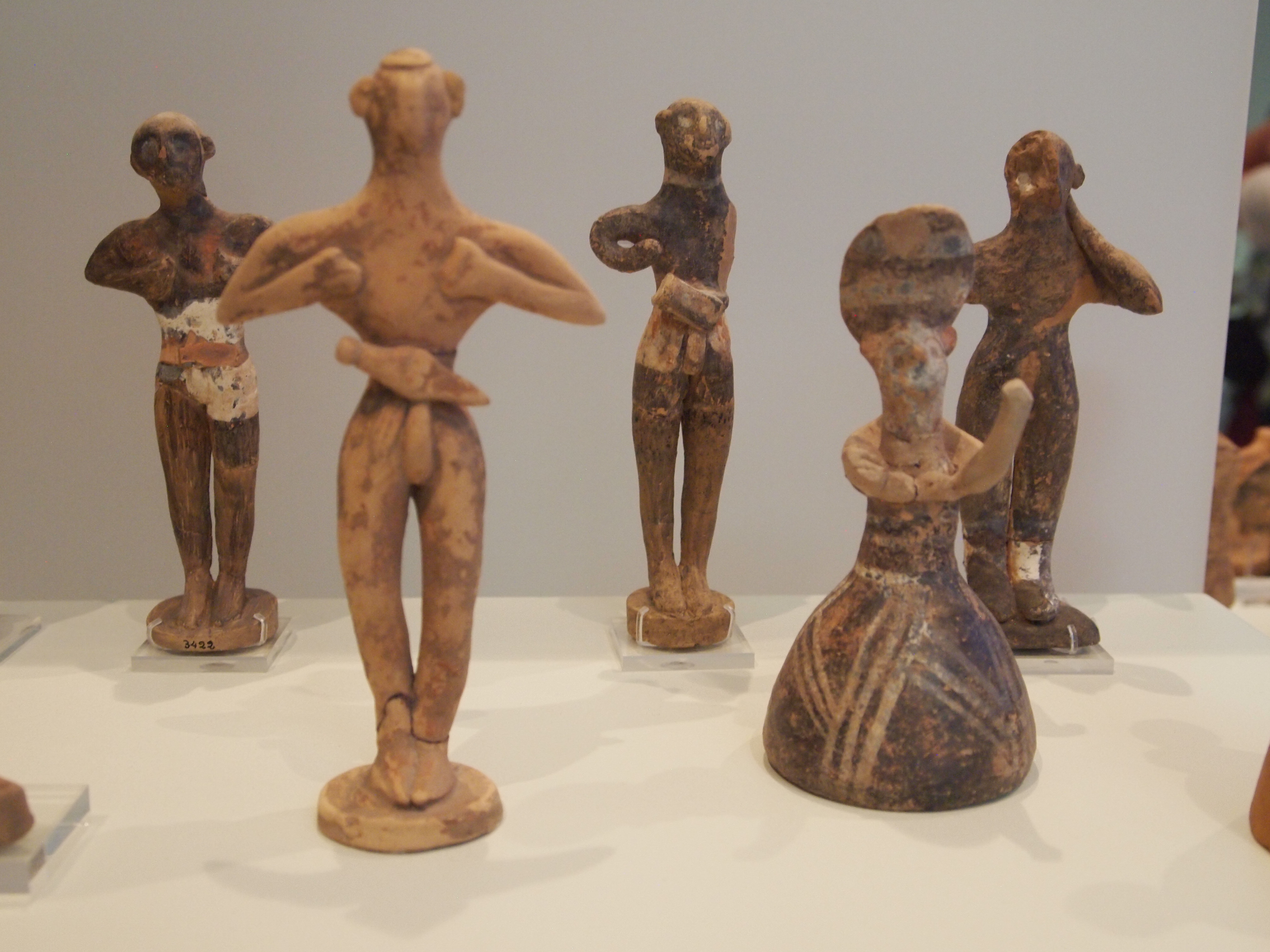


Back into the courtyard we experience this immense open space, common to all Minoan palaces. This was the scene for ceremonies which may well have included the bull leaping, depicted in so much Minoan art. Stand here, and hear the roar as the great bull leaping took place. Deadly, risky and impressive. These weren’t ordinary bulls, they were the extinct aurochs, at least twice the size of modern bulls, each horn might be nearly 3ft long … All Minoan palaces have great courtyards; did bull leaping take place in all of them?

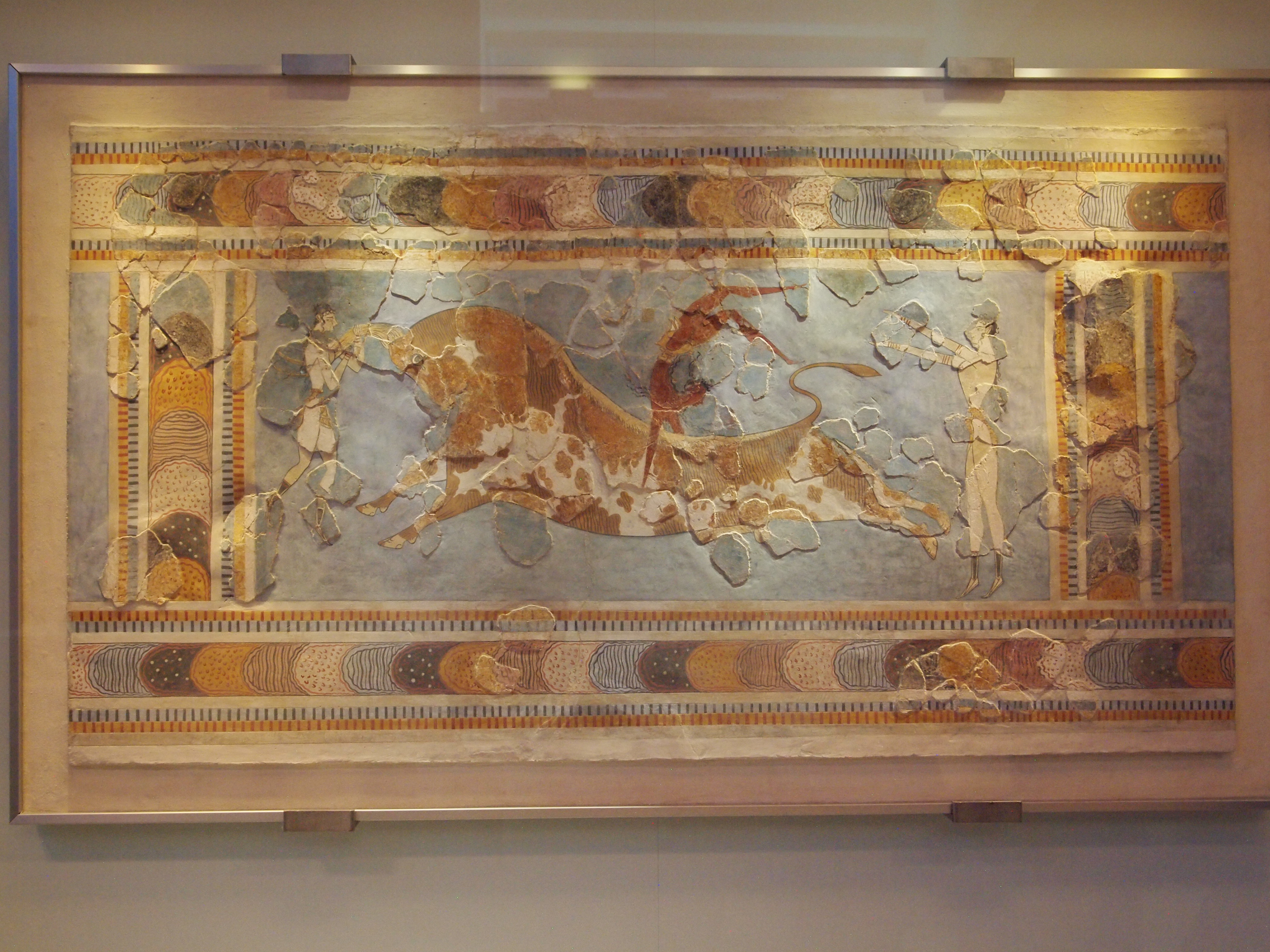
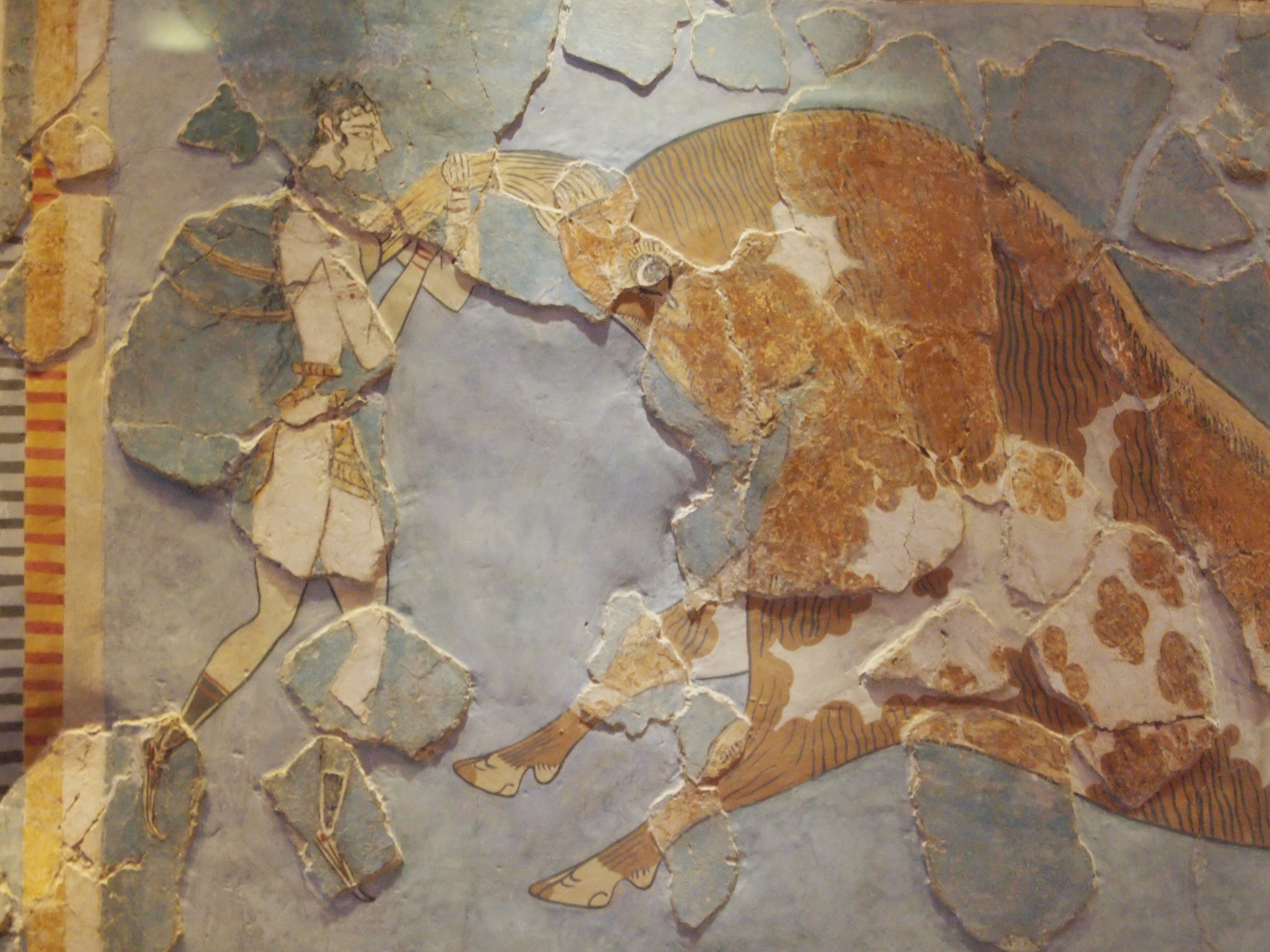




The adoration and/or celebration and/or control of the bull may have created the legend of the Minotaur that was told across the ancient world. Greek and Roman artists and literary works tell of the mythical half-man, half-bull who was born by the Queen Pasiphae when she became enamoured of the bull given by the sea god, Poseidon to the King Minos.
According to the myth, the taurus (bull) of King Minos (hence Minotaur) was given tribute of youths from Athens, until Theseus, aided by Minos’ daughter, Ariade and her ball of string, enable the youth to kill the bull and escape. Maybe the priest of Knossos wore a bull head-dress (creating the half-man, half-bull image) …




The monster was locked away in a maze, designed by the imprisoned Greek genius Daedalus. It is quite feasible that the complex palace gave rise to the stories of a maze, or labyrinth. Labrys was the Greek word for a double-headed axe, that was so much a feature of ceremony in Minoan Knossos. It was even inscribed into the stones – look out for this further along the route. So the labyrinth is ‘the place of the labrys/double headed axe’.





As we walk on, we gain a sense of the winding maze. Peer down into the reconstructed stairwell on the far side of the central courtyard, and imagine visiting from a village where multi-storeys and winding corridors were rarely encountered … Engineering and planning are required here.



Head to the end of the courtyard and down to the complex of buildings below the terrace. Look for the smart-edged walls of the lustral basin (cleansing purification bath) and the water management … there are a number of drains and even a pipe, narrowed at the joint to improve water pressure, throughout the site. It’s always worth noting the water pipes on an ancient site … a sure sign of ‘civilised’ settlements.
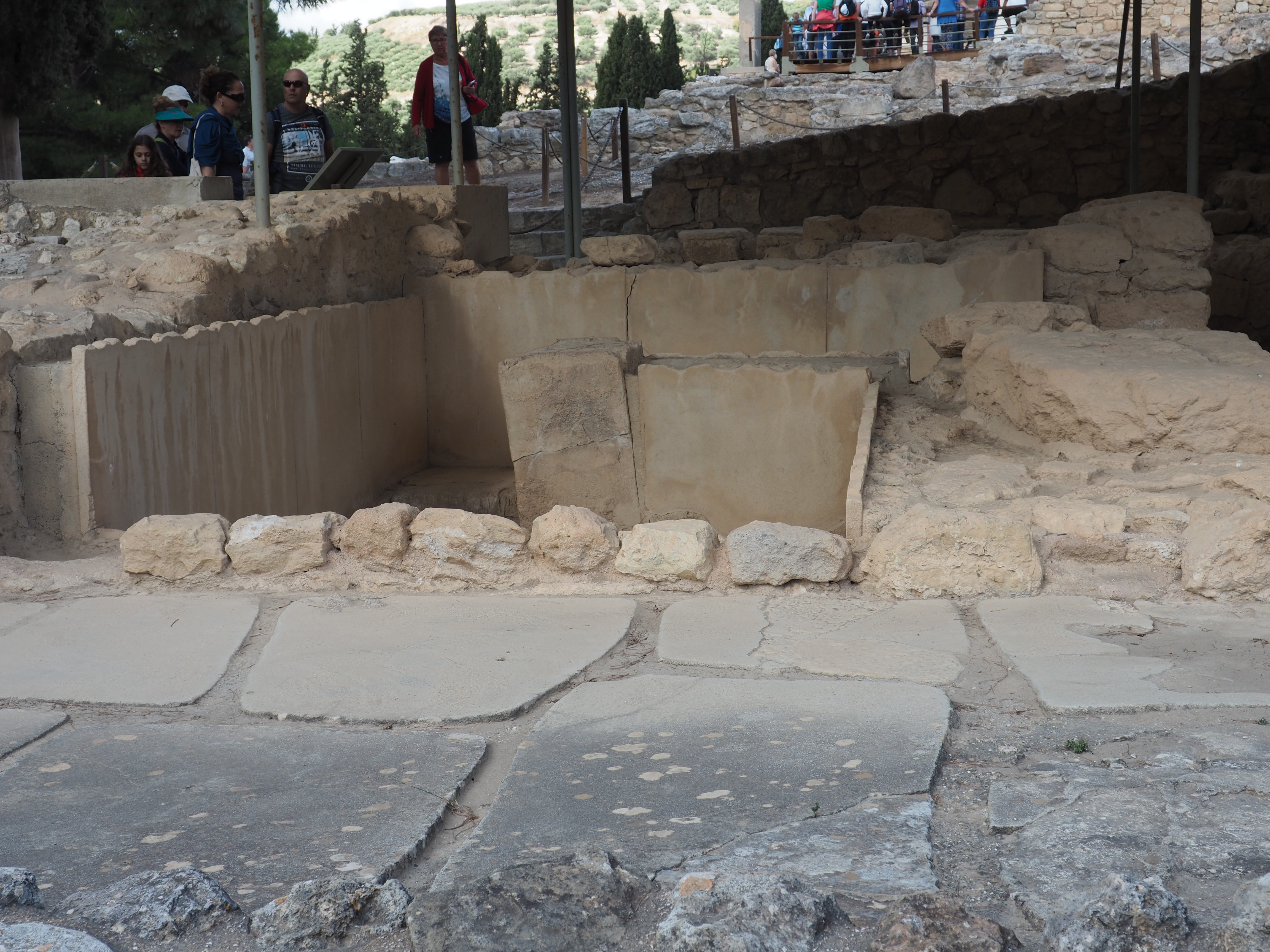




So far, we have found evidence of ceremonial pathways and courtyard, administrated storage, special ‘royal’ rooms, water management and grand architecture, decorated by paint and frescoes. As we move on, we see more of this in the ‘Queen’s Megaron’ (grand room) and then the King’s Megaron, It just dripped colourful and impressive grandeur.




You are now down on the sloping ground behind the terrace. We can peer UP the staircase we looked down. Some – the uncoloured yellower stone – are the original. More original stones lurk around a hidden corner – lumps of basalt, imported from mainland Greece, still being worked and some with saw marks in them. The workshop area was valued and sited within the palace area. We ascend back up, past huge pithoi, to the most famous reconstruction by Evans … but look down (always look down at a site!) and you see the paved road leading up to the central courtyard. The path came from the great gate (did Theseus walk this pavement?).


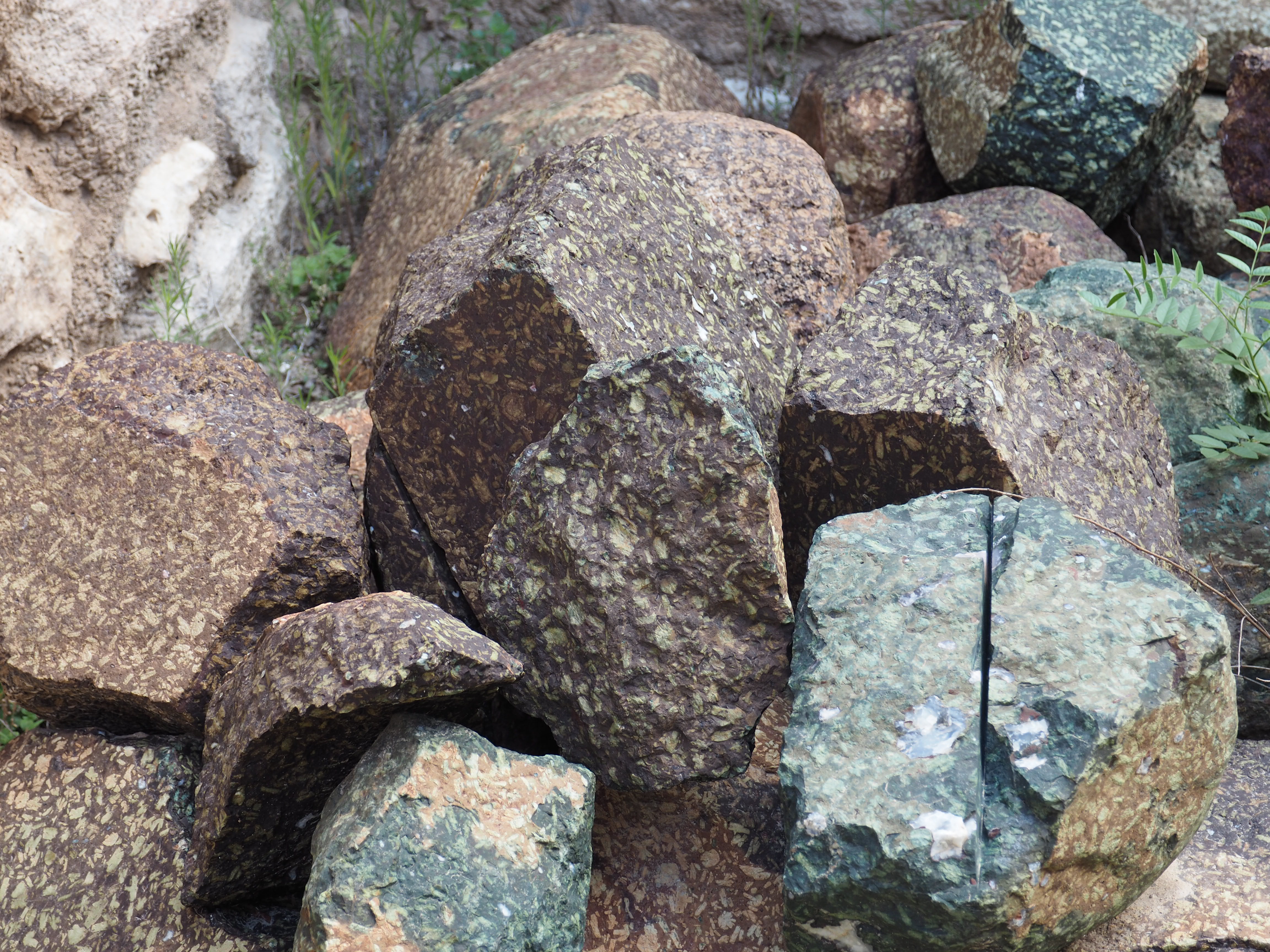

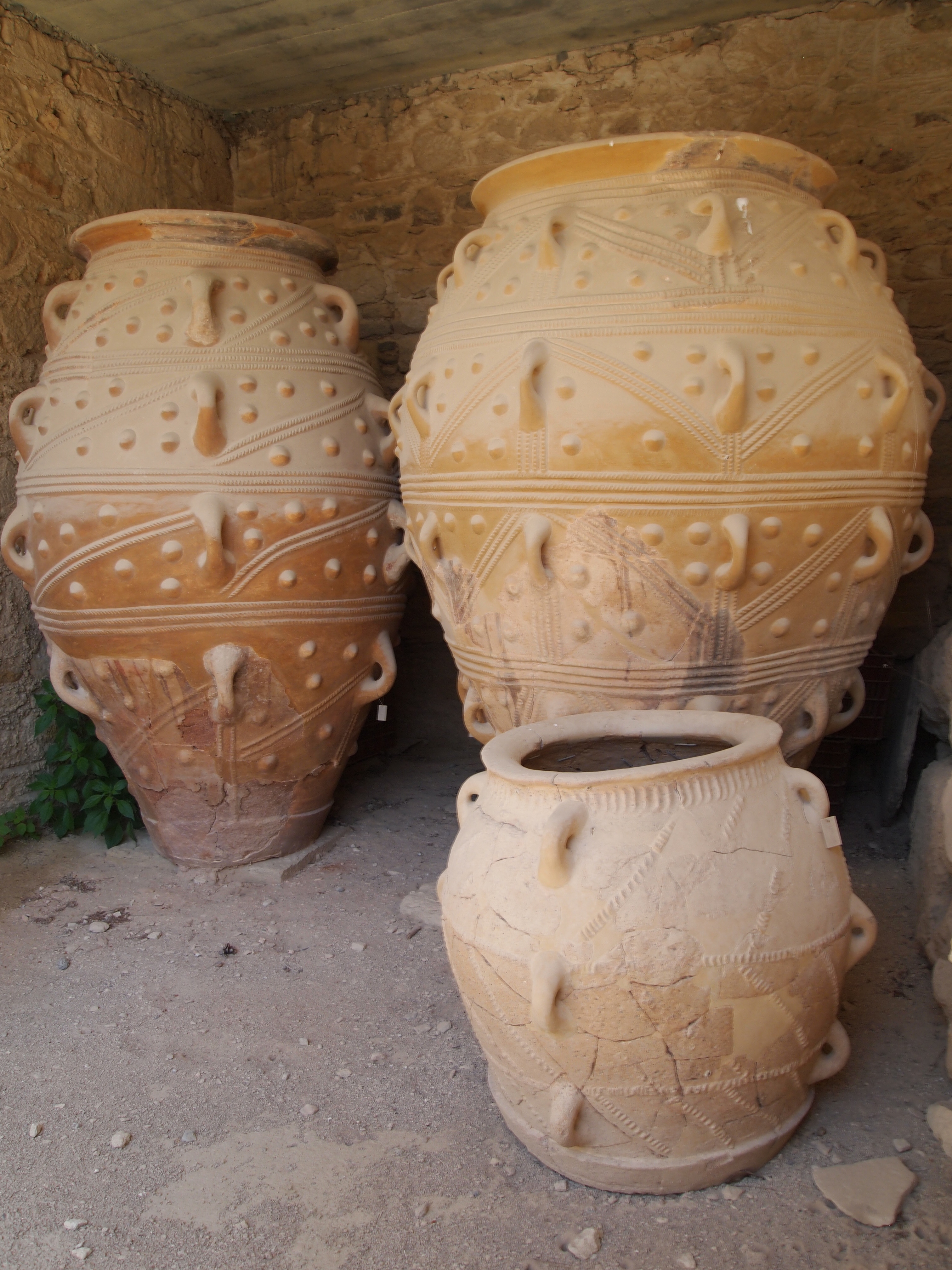


And, finally, we see another paved road. One that led to a theatre space, surrounded on three sides by steps/seats. The ‘Royal Road’ that leads away from the palace was your grand entrance (or exit) from this remarkable site. Clearly though, it was a ceremonial site too. It is described as the oldest road in Europe.




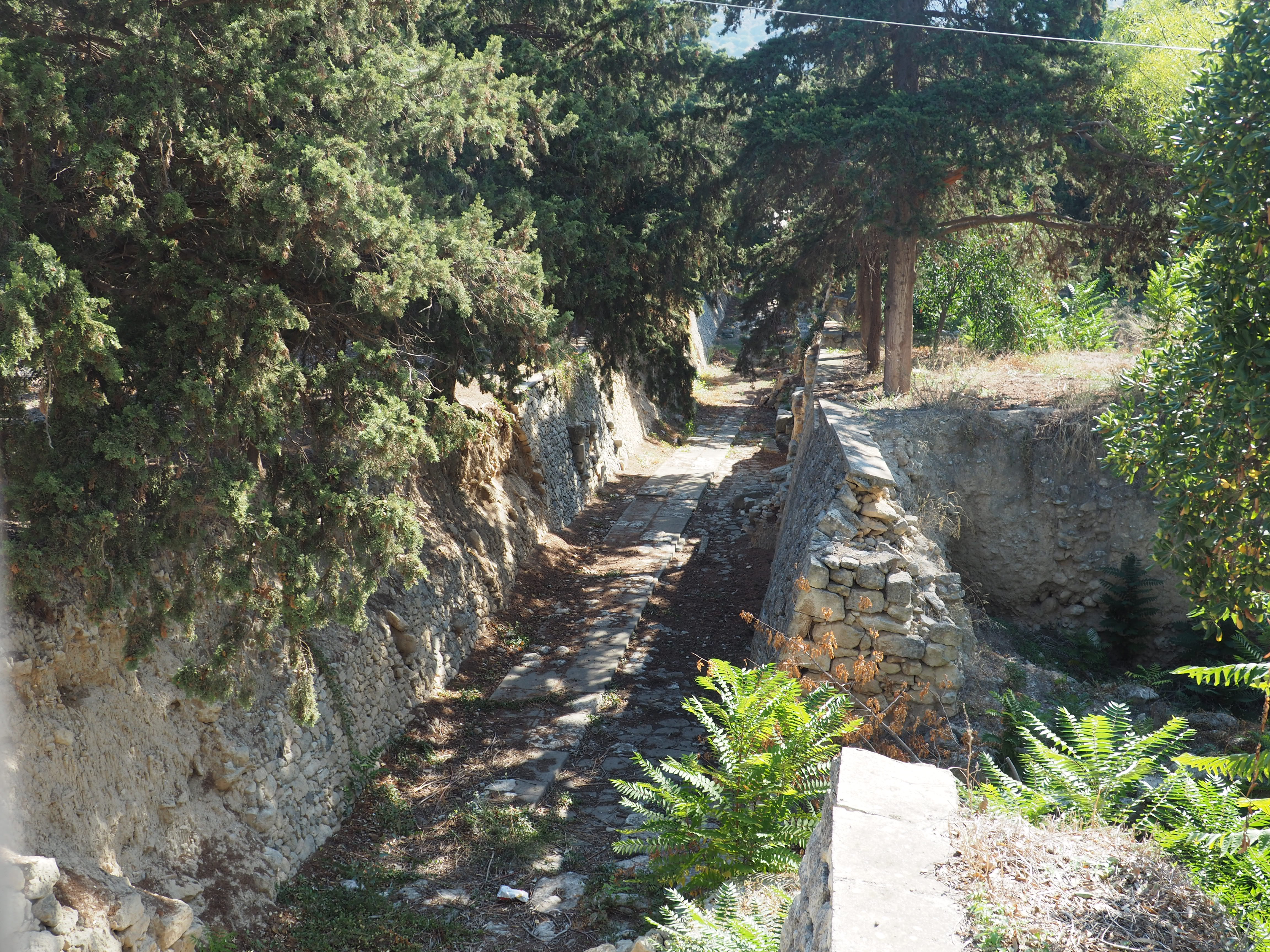
Our tour has picked out the features that appear in many Minoan palaces in Crete. Here, at the greatest Minoan palace, we can find the paved areas and roads, colourful frescoes and columns, the pillared architecture of winding corridors and staircases with light-wells and fresh breezes (Bronze Age air conditioning!), wrapped around a central courtyard. Pottery, the dating friend of archaeologists everywhere, is grand and imposing, despite its administrative purpose. In Heraklion museum, you can see the variety, imagination and individuality of the craft workers of Knossos.

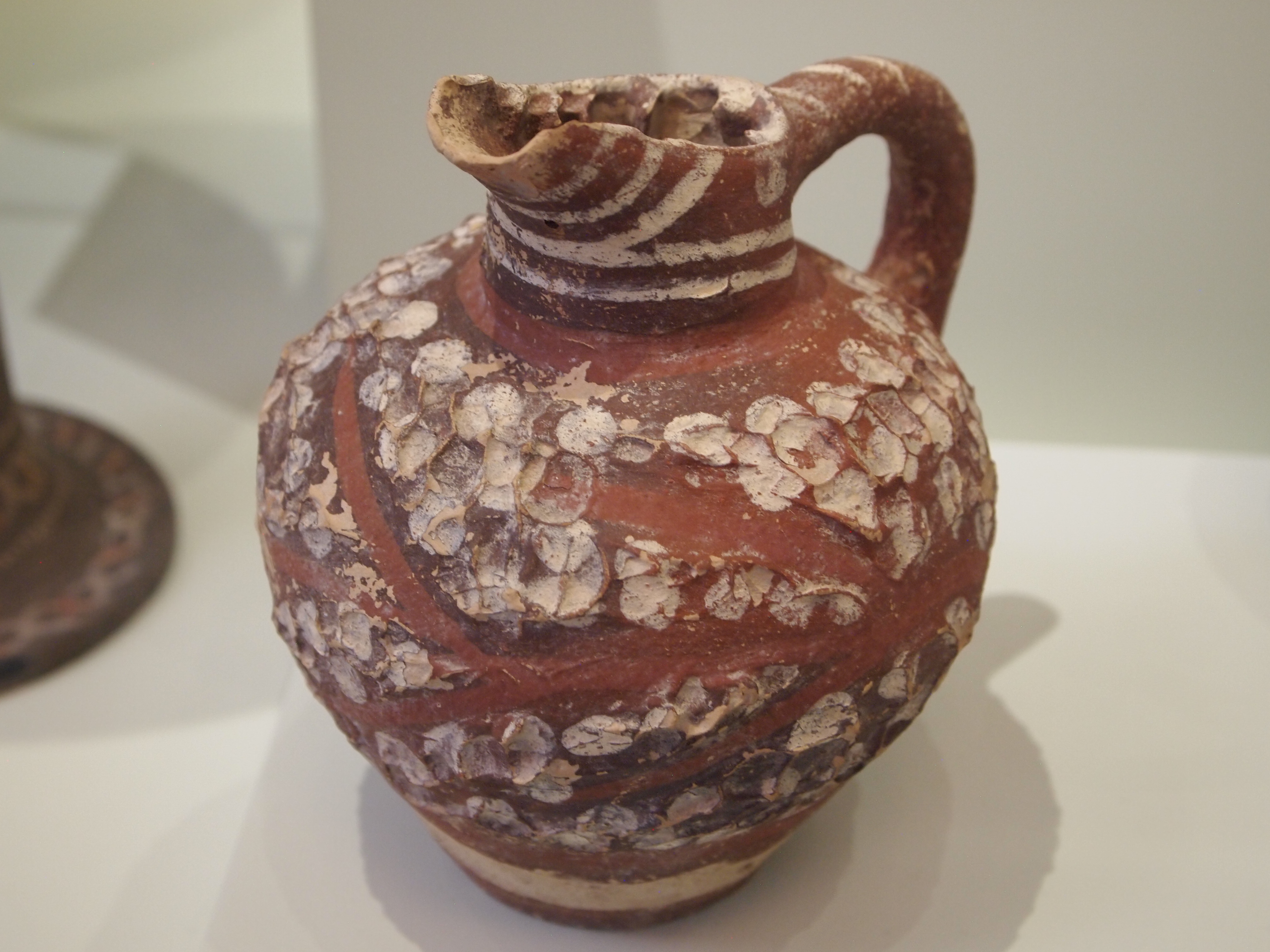



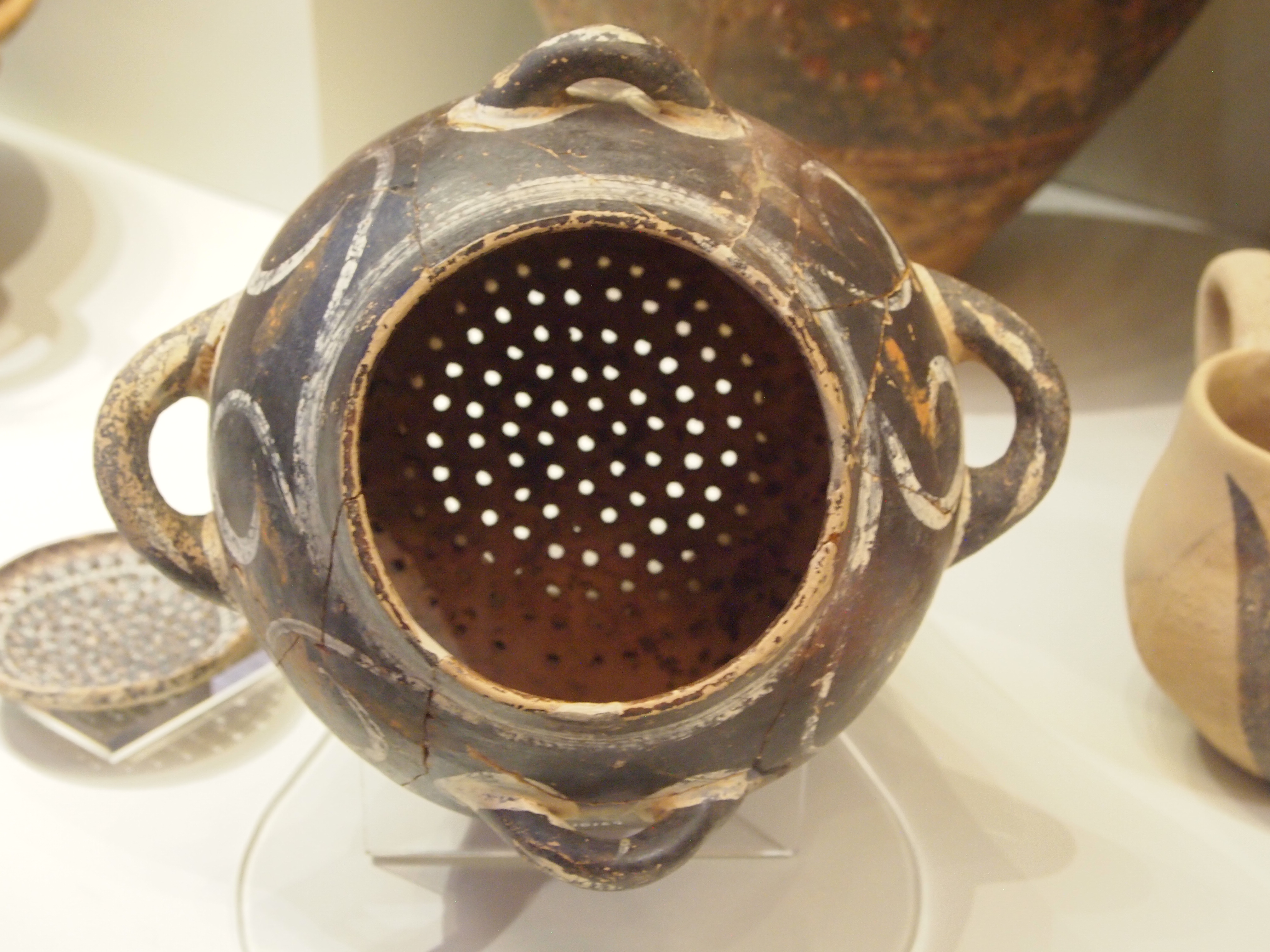

Knossos gives us a sense of sacred and imposing space. It transports us back to a very particular, distinctive vibrant time of ceremony and energy – processions and bull leaping included. The archaeological essence of Minoan culture is energetic art and colour, complex architecture and ceremony involving number of individuals and an audience. Although we have Linear A writing, it remains ‘prehistoric’ (no history is written down), but it is far from primitive.
And the Minoans certainly had their very own culture which they revelled in.
This Blog is free and created for educational purposes by Gillian Hovell, ‘The Muddy Archaeologist’.
For further details of Gillian’s varied work, online, in the media and in person on tours, courses, talks and events, visit http://www.muddyarchaeologist.co.uk
For online courses, visit https://muddyarchaeologist.thinkific.com

That was an excellent tour Gillian, it took me right back to the site!
LikeLike
Thank you! Glad you liked it. Such an amazing site, isn’t it!
LikeLike
Yes it is. I spent 3 weeks just touring Minoan sites a few years ago….
LikeLiked by 1 person
Pingback: A Sense of Place: MEANDERING THROUGH MINOAN KNOSSOS — The Muddy Archaeologist’s Blog | Die Goldene Landschaft
I visited the site 16 years ago and was enthralled by the site and how large it is. Thank you for sharing.
LikeLike